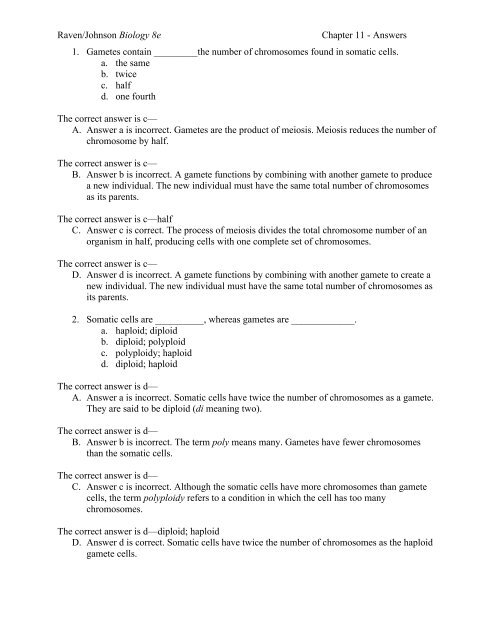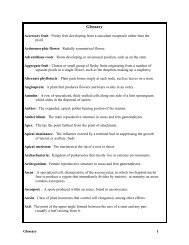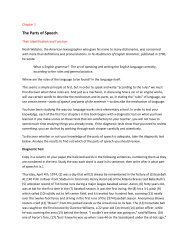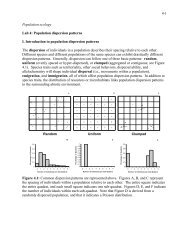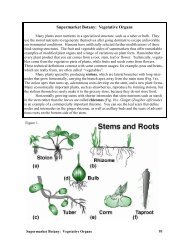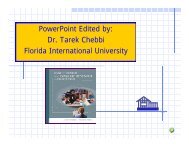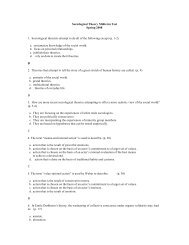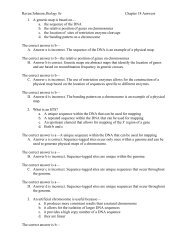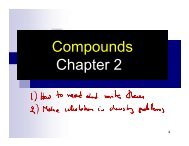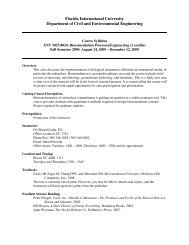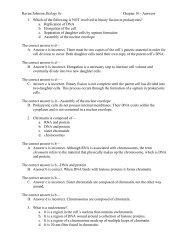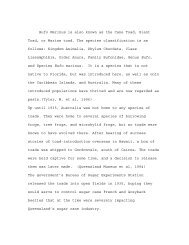Raven/Johnson Biology 8e Chapter 11 - Answers 1. Gametes ...
Raven/Johnson Biology 8e Chapter 11 - Answers 1. Gametes ...
Raven/Johnson Biology 8e Chapter 11 - Answers 1. Gametes ...
Create successful ePaper yourself
Turn your PDF publications into a flip-book with our unique Google optimized e-Paper software.
<strong>Raven</strong>/<strong>Johnson</strong> <strong>Biology</strong> <strong>8e</strong><br />
<strong>Chapter</strong> <strong>11</strong> - <strong>Answers</strong><br />
<strong>1.</strong> <strong>Gametes</strong> contain _________the number of chromosomes found in somatic cells.<br />
a. the same<br />
b. twice<br />
c. half<br />
d. one fourth<br />
The correct answer is c—<br />
A. Answer a is incorrect. <strong>Gametes</strong> are the product of meiosis. Meiosis reduces the number of<br />
chromosome by half.<br />
The correct answer is c—<br />
B. Answer b is incorrect. A gamete functions by combining with another gamete to produce<br />
a new individual. The new individual must have the same total number of chromosomes<br />
as its parents.<br />
The correct answer is c—half<br />
C. Answer c is correct. The process of meiosis divides the total chromosome number of an<br />
organism in half, producing cells with one complete set of chromosomes.<br />
The correct answer is c—<br />
D. Answer d is incorrect. A gamete functions by combining with another gamete to create a<br />
new individual. The new individual must have the same total number of chromosomes as<br />
its parents.<br />
2. Somatic cells are __________, whereas gametes are _____________.<br />
a. haploid; diploid<br />
b. diploid; polyploid<br />
c. polyploidy; haploid<br />
d. diploid; haploid<br />
The correct answer is d—<br />
A. Answer a is incorrect. Somatic cells have twice the number of chromosomes as a gamete.<br />
They are said to be diploid (di meaning two).<br />
The correct answer is d—<br />
B. Answer b is incorrect. The term poly means many. <strong>Gametes</strong> have fewer chromosomes<br />
than the somatic cells.<br />
The correct answer is d—<br />
C. Answer c is incorrect. Although the somatic cells have more chromosomes than gamete<br />
cells, the term polyploidy refers to a condition in which the cell has too many<br />
chromosomes.<br />
The correct answer is d—diploid; haploid<br />
D. Answer d is correct. Somatic cells have twice the number of chromosomes as the haploid<br />
gamete cells.
<strong>Raven</strong>/<strong>Johnson</strong> <strong>Biology</strong> <strong>8e</strong><br />
<strong>Chapter</strong> <strong>11</strong> - <strong>Answers</strong><br />
3. An organism is said to be diploid if—<br />
a. it contains genetic information from two parents<br />
b. it is multicellular<br />
c. it reproduces<br />
d. undergoes mitotic cell division<br />
The correct answer is a—it contains genetic information from two parents<br />
A. Answer a is correct. The combination of two haploid gametes results in the production of<br />
a diploid organism with two complete sets of chromosomes.<br />
The correct answer is a—<br />
B. Answer b is incorrect. Some organisms (ferns, for example) have a multicellular haploid<br />
stage in their life cycle.<br />
The correct answer is a—<br />
C. Answer c is incorrect. Some organisms produce gametes through mitosis from the haploid<br />
stage of their life cycle.<br />
The correct answer is a—<br />
D. Answer d is incorrect. Mitotic cell division is not limited to diploid cells. Haploid<br />
organisms use mitosis to produce gametes to complete their life cycle.<br />
4. What are homologous chromosomes<br />
a. The two halves of a replicated chromosome<br />
b. Two identical chromosomes from one parent<br />
c. Two genetically identical chromosomes, one from each parent<br />
d. Two genetically similar chromosomes, one from each parent<br />
The correct answer is d—<br />
A. Answer a is incorrect. The two halves of a replicated chromosome are called sister<br />
chromatids.<br />
The correct answer is d—<br />
B. Answer b is incorrect. Homologous chromosomes are the equivalent genetic material<br />
from each parent.<br />
The correct answer is d—<br />
C. Answer c is incorrect. Homologous chromosomes represent equivalent genetic material<br />
from each parent. It does not have to be identical.<br />
The correct answer is d—Two genetically similar chromosomes, one from each parent<br />
D. Answer d is correct. Chromosomes are said to be homologous because they carry the<br />
equivalent, but not identical, genetic material.
<strong>Raven</strong>/<strong>Johnson</strong> <strong>Biology</strong> <strong>8e</strong><br />
<strong>Chapter</strong> <strong>11</strong> - <strong>Answers</strong><br />
5. When homologous chromosomes form chiasmata, they are—<br />
a. exchanging genetic information<br />
b. reproducing their DNA<br />
c. separating their sister chromatids<br />
d. replicating their chromatids<br />
The correct answer is a—exchanging genetic information<br />
A. Answer a is correct. The formation of chiasmata during crossing over allows for the<br />
transfer and exchange of genetic information between two homologous chromosomes.<br />
The correct answer is a—<br />
B. Answer b is incorrect. Reproduction of DNA precedes meiosis and occurs during S phase<br />
of the cell cycle.<br />
The correct answer is a—<br />
C. Answer c is incorrect. The separation of sister chromatids occurs during anaphase of<br />
meiosis II and is not associated with the formation of chiasmata.<br />
The correct answer is a—<br />
D. Answer d is incorrect. Replication of chromosomal material occurs during S phase.<br />
6. Crossing over involves each of the following with the exception of—<br />
a. the transfer of DNA between two nonsister chromatids<br />
b. the transfer of DNA between two sister chromatids<br />
c. the formation of a synaptonemal complex<br />
d. the alignment of homologous chromosomes<br />
The correct answer is b—<br />
A. Answer a is incorrect. Crossing over does occur between nonsister chromatids.<br />
The correct answer is b—the transfer of DNA between two sister chromatids<br />
B. Answer b is correct. The transfer of DNA between sister chromatids would not represent<br />
a net change. Sister chromatids are identical copies. Crossing over between sister<br />
chromatids is suppressed during meiosis.<br />
The correct answer is b—<br />
C. Answer c is incorrect. The synaptonemal complex is required for crossing over to occur.<br />
The correct answer is b—<br />
D. Answer d is incorrect. Crossing over can only occur if the homologous chromosomes are<br />
aligned.<br />
7. Terminal chiasmata are seen during which phase of meiosis<br />
a. Anaphase I<br />
b. Prophase I<br />
c. Metaphase I<br />
d. Metaphase II
<strong>Raven</strong>/<strong>Johnson</strong> <strong>Biology</strong> <strong>8e</strong><br />
<strong>Chapter</strong> <strong>11</strong> - <strong>Answers</strong><br />
The correct answer is c—<br />
A. Answer a is incorrect. Homologous chromosomes are separated during anaphase I.<br />
The correct answer is c—<br />
B. Answer b is incorrect. Crossing over has only begun during prophase I.<br />
The correct answer is c—Metaphase I<br />
C. Answer c is correct. The terminal chiasmata hold the homologous chromosomes together<br />
at the metaphase plate during meiosis I.<br />
The correct answer is c—<br />
D. Answer d is incorrect. The homologous chromosomes have already separated during<br />
metaphase of meiosis I. The chiasmata are no longer visible during meiosis II.<br />
8. Which of the following occurs during anaphase I<br />
a. Sister chromatids are separated and move to the poles.<br />
b. Homologous chromosomes move to opposite poles.<br />
c. Homologous chromosomes align at the middle of the cell.<br />
d. All the chromosomes align independently at the middle of the cell.<br />
The correct answer is b—<br />
A. Answer a is incorrect. The sister chromatids remain connected at their centromeres<br />
through all of meiosis I.<br />
The correct answer is b—Homologous chromosomes move to opposite poles.<br />
B. Answer b is correct. Meiosis I is characterized by the separation of homologous<br />
chromosomes during anaphase. This is the step that reduces the number of chromosomes.<br />
The correct answer is b—<br />
C. Answer c is incorrect. The homologous chromosomes align during metaphase of meiosis<br />
I.<br />
The correct answer is b—<br />
D. Answer d is incorrect. Meiosis I is characterized by the pairing of homologous<br />
chromosomes.<br />
9. Telophase 1 results in the production of—<br />
a. four cells containing one homologue of each homologous pair<br />
b. two cells containing both homologues of each homologous pair<br />
c. four cells containing both homologues of each homologous pair<br />
d. two cells containing one homologue of each homologous pair<br />
The correct answer is d—<br />
A. Answer a is incorrect. Meiosis I produces cells containing one homologue of each<br />
homologous pair, however, only two cells are produced at this stage.<br />
The correct answer is d—
<strong>Raven</strong>/<strong>Johnson</strong> <strong>Biology</strong> <strong>8e</strong><br />
<strong>Chapter</strong> <strong>11</strong> - <strong>Answers</strong><br />
B. Answer b is incorrect. The first round of cell division results in the production of two<br />
daughter cells; however, the process of meiosis I results in the production of cells<br />
containing one homologue of each homologous pair.<br />
The correct answer is d—<br />
C. Answer c is incorrect. The first round of meiotic cell division produced two daughter cells<br />
containing one homologue of each homologous pair.<br />
The correct answer is d—two cells containing one homologue of each homologous pair<br />
D. Answer d is correct. Meiosis I separates the homologous chromosomes, resulting in two<br />
daughter cells containing one homologue of each homologous pair.<br />
10. Which of the following does NOT contribute to genetic diversity<br />
a. Independent assortment<br />
b. Recombination<br />
c. Metaphase of meiosis II<br />
d. Metaphase of meiosis I<br />
The correct answer is c—<br />
A. Answer a is incorrect. Independent assortment, the random alignment of chromosomes at<br />
the metaphase plate during metaphase I, generates genetic diversity by “shuffling” the<br />
maternal and paternal homologues between the two daughter cells.<br />
The correct answer is c—<br />
B. Answer b is incorrect. Recombination, or crossing over, generates genetic diversity by<br />
creating new combinations of genetic information.<br />
The correct answer is c—Metaphase of meiosis II<br />
C. Answer c is correct. Meiosis II is most like mitosis and does not result in any new<br />
combinations of genetic material.<br />
The correct answer is c—<br />
D. Answer d is incorrect. Homologous chromosomes randomly align on the metaphase plate<br />
during meiosis I. This independent assortment results in different distributions of maternal<br />
and paternal homologous chromosomes.<br />
<strong>11</strong>. How does S phase following meiosis I differ from S phase in mitosis<br />
a. DNA replication takes less time because the cell is haploid.<br />
b. DNA does not replicate during S phase following meiosis I.<br />
c. DNA replication takes more time due to cohesin proteins.<br />
d. There is no difference.<br />
The correct answer is b—<br />
A. Answer a is incorrect. The DNA is already replicated prior to beginning meiosis I. The<br />
sister chromatids are still connected.<br />
The correct answer is b—DNA does not replicate during S phase following meiosis I.<br />
B. Answer b is correct. DNA replication is suppressed between the two divisions of meiosis.<br />
The replicated sister chromatids are still attached.
<strong>Raven</strong>/<strong>Johnson</strong> <strong>Biology</strong> <strong>8e</strong><br />
<strong>Chapter</strong> <strong>11</strong> - <strong>Answers</strong><br />
The correct answer is b—<br />
C. Answer c is incorrect. Although cohesin proteins are present in the chromosomes, there is<br />
no need to replicate the DNA.<br />
The correct answer is b—<br />
D. Answer d is incorrect. Replication does not occur during the S phase preceding meiosis II.<br />
12. What occurs during anaphase of meiosis II<br />
a. The homologous chromosomes align.<br />
b. Sister chromatids are pulled to opposite poles.<br />
c. Homologous chromosomes are pulled to opposite poles.<br />
d. The haploid chromosomes line up.<br />
The correct answer is b—<br />
A. Answer a is incorrect. The homologues have already been separated during anaphase of<br />
meiosis I.<br />
The correct answer is b—Sister chromatids are pulled to opposite poles.<br />
B. Answer b is correct. Sister chromatids are separated during meiosis II.<br />
The correct answer is b—<br />
C. Answer c is incorrect. The homologues have already been separated during anaphase of<br />
meiosis I.<br />
The correct answer is b—<br />
D. Answer d is incorrect. Anaphase is the process of separating chromatids to opposite poles.<br />
13. What is an aneuploid gamete<br />
a. A diploid gamete cell<br />
b. A haploid gamete cell<br />
c. A gamete cell with the wrong number of chromosomes<br />
d. A haploid somatic cell<br />
The correct answer is c—<br />
A. Answer a is incorrect. A cell with the complete diploid chromosome number cannot be<br />
called a gamete. Aneuploid gametes typically have one too few or one too many<br />
chromosomes—not a full extra set.<br />
The correct answer is c—<br />
B. Answer b is incorrect. A haploid gamete would have the correct number of chromosomes.<br />
Aneuploid gametes have an abnormal chromosome number.<br />
The correct answer is c—A gamete cell with the wrong number of chromosomes<br />
C. Answer c is correct. Aneuploid gametes occur when the proper segregation of the<br />
chromosomes is disrupted.<br />
The correct answer is c—<br />
D. Answer d is incorrect. A somatic cell is not a gamete.
<strong>Raven</strong>/<strong>Johnson</strong> <strong>Biology</strong> <strong>8e</strong><br />
<strong>Chapter</strong> <strong>11</strong> - <strong>Answers</strong><br />
14. Which of the following is NOT a distinct feature of meiosis<br />
a. Pairing and exchange of genetic material between homologous chromosomes<br />
b. Attachment of sister kinetochores to spindle microtubules<br />
c. Movement of sister chromatids to the same pole<br />
d. Suppression of DNA replication<br />
The correct answer is b—<br />
A. Answer a is incorrect. The exchange of genetic material between homologues is a unique<br />
property of meiotic cell division.<br />
The correct answer is b—Attachment of sister kinetochores to spindle microtubules<br />
B. Answer b is correct. Sister chromatids attach their kinetochores to the microtubule spindle<br />
during both mitosis and meiosis.<br />
The correct answer is b—<br />
C. Answer c is incorrect. The separation of homologues during anaphase I is a distinct<br />
feature of meiosis.<br />
The correct answer is b—<br />
D. Answer d is incorrect. DNA replication must occur between each mitotic cell division, but<br />
is not required during S phase between meiosis I and II.<br />
15. Which phase of meiosis I is most similar to the comparable phase in mitosis<br />
a. Prophase I<br />
b. Metaphase I<br />
c. Anaphase I<br />
d. Telophase I<br />
The correct answer is d—<br />
A. Answer a is incorrect. Prophase I of meiosis is different from prophase of mitosis because<br />
crossing over occurs during this meiotic phase.<br />
The correct answer is d—<br />
B. Answer b is incorrect. Homologous chromosomes align during metaphase I. The<br />
chromosomes do not align during mitosis.<br />
The correct answer is d—<br />
C. Answer c is incorrect. Anaphase I involves the separation of homologous chromosomes.<br />
There is no separation of homologues during mitosis.<br />
The correct answer is d—Telophase I<br />
D. Answer d is correct. Telophase of meiosis I and mitosis both involve the reformation of<br />
the nuclear envelope followed by cytokinesis.
<strong>Raven</strong>/<strong>Johnson</strong> <strong>Biology</strong> <strong>8e</strong><br />
Challenge Questions<br />
<strong>Chapter</strong> <strong>11</strong> - <strong>Answers</strong><br />
<strong>1.</strong> Diagram the process of meiosis for an imaginary cell with six chromosomes in a<br />
diploid cell.<br />
a. How many homologous pairs are present in this cell Create a drawing that<br />
distinguishes between homologous pairs.<br />
b. Label each homolog to indicate whether it is maternal (M) or paternal (P).<br />
c. Draw a new cell showing how these chromosomes would arrange themselves<br />
during metaphase of meiosis <strong>1.</strong> Do all the maternal homologues have to line<br />
up on the same side of the cell<br />
d. How would this picture differ if you were diagramming anaphase of meiosis<br />
II<br />
Answer—Compare your figure with Figure <strong>11</strong>.8.<br />
a. There would be three homologous pairs of chromosomes for an organism with a diploid<br />
number of six.<br />
b. For each pair of homologues, you should now have a maternal and paternal pair.<br />
c. Many possible arrangements are possible. The key to your image is that it must show<br />
the homologues aligned pairwise—not single-file along the metaphase plate. The maternal and<br />
paternal homologues do not have to align on the same side of the cell. Independent assortment<br />
means that the pairs can be mixed.<br />
d. A diagram of metaphase II would not include the homologous pairs. The pairs have<br />
separated during anaphase of meiosis I. Your picture should diagram the haploid number of<br />
chromosomes, in this case three, aligned single-file along the metaphase plate. Remember that<br />
meiosis II is most similar to mitosis.<br />
2. Mules are the offspring of the mating of a horse and a donkey. Mules are unable to<br />
reproduce. A horse has a total of 64 chromosomes, whereas donkeys have 62<br />
chromosomes. Use your knowledge of meiosis to predict the diploid chromosome<br />
number of a mule. Propose a possible explanation for the inability of mules to<br />
reproduce.<br />
Answer—The diploid chromosome number of a mule is 63. The mule receives 32 chromosomes<br />
from its horse parent (diploid 64: haploid 32) and another 31 chromosomes from its donkey<br />
parent (diploid 61: haploid 31). 32 + 31 = 63. The haploid number for the mule would be one half<br />
the diploid number 63 ÷ 2 = 3<strong>1.</strong>5. Can there be a 0.5 chromosome When the homologues align<br />
during metaphase of meiosis I there will be one chromosome without a partner. The meiotic<br />
spindle will not work and so no gametes will be formed.<br />
3. Compare the processes of independent assortment and crossing over. Which process<br />
has the greatest influence on genetic diversity<br />
Answer—Independent assortment involves the random distribution of maternal versus paternal<br />
homologues into the daughter cells produced during meiosis I. The number of possible<br />
combinations of maternal and paternal pairings is on the order of 2 n , where n is the diploid<br />
number of chromosomes. Crossing over involves the exchange of genetic material between<br />
homologous chromosomes, creating new combinations of genes on a single chromosome.<br />
Crossing over does not occur all the time, nor does it influence every homologous pair. For these
<strong>Raven</strong>/<strong>Johnson</strong> <strong>Biology</strong> <strong>8e</strong><br />
<strong>Chapter</strong> <strong>11</strong> - <strong>Answers</strong><br />
reasons, it is reasonable to conclude that independent assortment has the greatest influence on<br />
genetic diversity.<br />
4. Aneuploid gametes are cells that contain the wrong number of chromosomes.<br />
Aneuploidy occurs as a result of nondisjunction, or lack of separation of the<br />
chromosomes during either phase of meiosis.<br />
a. At what point in meiotic cell division would nondisjunction occur<br />
b. Imagine a cell had a diploid chromosome number of 4. Create a diagram to<br />
illustrate the effects of nondisjunction of one pair of homologous<br />
chromosomes in meiosis I versus meiosis II.<br />
Answer—a. Nondisjunction occurs at the point when the chromosomes are being pulled to<br />
opposite poles. This occurs during anaphase.<br />
b. Use an image like Figure <strong>11</strong>.8 and illustrate nondisjunction at anaphase I versus<br />
anaphase II<br />
Anaphase I nondisjunction:
<strong>Raven</strong>/<strong>Johnson</strong> <strong>Biology</strong> <strong>8e</strong><br />
<strong>Chapter</strong> <strong>11</strong> - <strong>Answers</strong><br />
Anaphase II nondisjunction:


